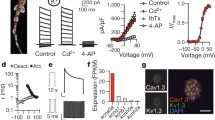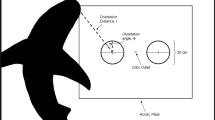Abstract
The adaptations of elasmobranch sensory systems can be studied by linking the morphological structure with the natural behavior and ecology of the organism. This paper presents the first step in a ‘neuroecological’ approach to interpret the spatial arrangement of the electrosensory ampullary organs in elasmobranch fishes. A brief review of the structure and function of the ampullae of Lorenzini is provided for interpretation of the organ system morphology in relation to the detection of dipole and uniform electric fields. The spatial projections of canals from discrete ampullary clusters were determined for the barndoor skate, Raja laevis, based upon a published figure in Raschi (1986), and measured directly from the head of the white shark, Carcharodon carcharias. The dorsoventrally flattened body of the skate restricts the projections of long canals to the horizontal plane. There is a distinct difference between dorsal and ventral projection patterns in all groups. Notable within-cluster features include a relatively long canal subgroup in the dorsal superficial ophthalmic (SOd) and dorsal hyoid (HYOd) clusters that are oriented parallel (bidirectionally) to the longitudinal axis of the body. It is postulated that this subgroup of canals may be important for detection and orientation to weak uniform fields. Ventral canal projections in the skate are primarily lateral, with the exception of the hyoid (HYOv) that also projects medially. This wide dispersion may function for the detection of prey located below the body and pectoral fins of the skate, and may also be used for orientation behavior. The mandibular canals located near the margin of the lower jaw (of both study species) are ideally positioned for use during prey manipulation or capture, and possibly for interspecific courtship or biting. The head of the white shark, which lacks the hyoid clusters, is ovoid in cross section and thus ampullary canals can project into three-dimensional space. The SOd and superficial ophthalmic ventral (SOv) clusters show strong rostral, dorsal and lateral projection components, whereas the SOv also detects rostral fields under the snout. In the sagittal plane, the SOv and SOd have robust dorsal projections as well as ventral in the SOv. Most notable are canal projections in the white shark buccal (BUC) ampullary cluster, which has a radial turnstile configuration on the ventrolateral side of the snout. The turnstile design and tilt between orthogonal planes indicates the white shark BUC may function in detection of uniform fields, including magnetically induced electric fields that may be used in orientation behaviors. These data can be used in future neuroecology behavioral performance experiments to (1) test for possible specializations of cluster groups to different natural electric stimuli, (2) the possibility of specialized canal subgroups within a cluster, and (3) test several models of navigation that argue for the use of geomagnetically induced electric cues.
Similar content being viewed by others
References
Ainley, D.G., R.P. Henderson, H.R. Huber, R.J. Boekelheide, S.G. Allen & T.L. McElroy. 1985. Dynamics of white shark/pinniped interactions in the Gulf of Farallones. S. Calif. Acad. Sci. Mem. 9: 109–122.
Barry, K.L. & C.W. Hawryshyn. 1999. Spectral sensitivity of the Hawaiian saddle wrasse, Thalassoma duperrey, and implications for visually mediated behaviour on coral reefs. Env. Biol. Fish. 56: 429–442.
Blonder, B. I. & W. S. Alevizon. 1988. Prey discrimination and electroreception in the stingray Dasyatis Sabina. Copeia 1988: 33–36.
Bodznick, D. & A.W. Schmidt. 1984. Somatotopy within the medullary electrosensory nucleus of the skate, Raja erinacea. J. Comp. Neurol. 225: 581–590.
Bratton, B.O. & J.L. Ayers. 1987. Observations on the electric discharge of two skate species (Chondrichthyes: Rajidae) and its relationship to behavior. Env. Biol. Fish. 20: 241–254.
Carey, F.G. & J. Scharrold. 1990. Movements of blue sharks (Prionace glauca) in course and depth. Mar. Biol. 106: 329–342.
Chu, Y.T. & Q.W. Wen. 1979. A study of the lateral line canals system and that of Lorenzini ampullae and tubules of elasmobranchiate fishes of China. Monograph of Fishes of China, 2, Shanghai Science Technology Press, Shanghai. 132 pp. (in Chinese).
Dijkgraaf, S. & A.J. Kalmijn. 1966. Versuche zur biologischen Bedeutung der Lorenzinischen Ampullen bei den Elasmobranchiern. Z. Vergl. Physiol. 53: 187–194.
Doyle, J. 1963. The acid mucopolysaccharides in the glands of Lorenzini of elasmobranch fish. Biochem. J. 88: 7.
Ewart, J.C. & J.C. Mitchell. 1891. On the lateral sense organs of elasmobranchs. II. The sensory canals of the common skate (Raja batis). Trans. R. Soc. Edin. 37: 87–105.
Hernandez, P. & P.J. Motta. 1997. Trophic consequences of differential performance: ontogeny of oral jaw-crushing performance in the sheephead, Archosargus probatocephalus (Teleostei, Sparidae) J. Zool. Lond. 243: 737–756.
Hueter, R.E. 1990. Adaptations for spatial vision in sharks. J. Exp. Zool. Suppl. 5: 130–141.
Kalmijn, A.J. 1971. The electric sense of sharks and rays. J. Exp. Biol. 55: 371–383.
Kalmijn, A.J. 1974. The detection of electric fields from inanimate and animate sources other than electric organs. pp. 147–200. In: A. Fessard (ed.) Handbook of Sensory Physiology, Vol III/3, Springer-Verlag, Berlin.
Kalmijn, A.J. 1978. Electric and magnetic sensory world of sharks, skates, and rays. pp. 507–528. In: E.S. Hodgson & R.F. Mathewson (ed.) Sensory Biology of Sharks, Skates, and Rays, Office of Naval Research, U.S. Government Printing Office, Washington, D.C.
Kalmijn, A.J. 1982. Electric and magnetic field detection in elasmobranch fishes. Science 218: 916–918.
Kalmijn, A.J. 1984. Theory of electromagnetic orientation: a further analysis. pp. 525–560. In: L. Bolis, R.D. Keynes & S.H.P. Maddrell (ed.) Comparative Physiology of Sensory Systems, Cambridge University Press, Cambridge.
Kalmijn, A.J. 1987. Electric and near-field acoustic detection, a comparative study. Acta Physiol. Scand. 161,Suppl. 638: 25–38.
Klimley, A.P. 1993. Highly directional swimming by scalloped hammerhead shark, Sphyrna lewini, and subsurface irradiance, temperature, bathymetry, and geomagnetic field. Mar. Biol. 117: 1–22.
Klimley, A.P., P. Pyle & S.D. Anderson. 1996. The behavior of white sharks and their pinniped prey during predatory attacks. pp. 175–191. In: A.P. Klimley & D.G. Ainley (ed.) Great White Sharks, Academic Press, San Diego.
Lamont, A. 1916. The lateral sense organs of elasmobranchs: the ampullary canals of the genus Raia. Trans. R. Soc. Edin. 51: 467–492.
Le Boeuf, B.J., M. Riedman & R.S. Keyes. 1982. White shark predation on pinnipeds in California coastal waters. U.S. Fish. Bull. 80: 891–895.
Long, D.J. & R.E. Jones. 1996. White shark predation and scavenging on cetaceans in the eastern north Pacific ocean. pp. 293–307. In: A.P. Klimley & D.G. Ainley (ed.) Great White Sharks, Academic Press, San Diego.
Lorenzini, S. 1678, Osservazioni intorno alle Torpedini. vol 1. Firenze. 136 pp.
McCosker, J.E. 1985. White shark attack behavior: observations of and speculations about predator and prey strategies. S. Calif. Acad. Sci. Mem. 9: 123–135.
McEachran, J.D. & T. Miyake. 1990. Phylogenetic interrelationships of skates: a working hypothesis (Chondrichthyes, Rajoidei). pp. 285–326. In: H.L. Pratt, S.H. Gruber & T. Taniuchi (ed.) Elasmobranchs as Living Resources: Advances in the Biology, Ecology, Systematics, and the Status of the Fisheries, U.S. Department of Commerce, NOAA Technical Report NMFS 90.
Montgomery, J.C. 1984. Frequency response characteristics of primary and secondary neurons in the electrosensory system of the thornback ray. Comp. Biochem. Physiol. 79A: 189–195.
Moss, S.A. 1977. Feeding mechanisms in sharks. Amer. Zool. 17: 355–364.
Motta, P.J., S.F. Norton & J.J. Luczkovich. 1995. Perspectives on the ecomorphology of bony fishes. Env. Biol. Fish. 44: 11–20.
Murray, R.W. 1960. Electrical sensitivity of the ampullae of Lorenzini. Nature 187: 957.
Murray, R.W. 1962. The response of the ampullae of Lorenzini in elasmobranchs to electrical stimulation. J. Exp. Biol. 39: 119–128.
Murray, R.W. & T.W. Potts. 1961. The composition of endolymph and other body fluids in elasmobranches. Comp. Biochem. Physiol. 2: 65–75.
Norris, H.W. 1929. The distribution and innervation of the ampullae of Lorenzini of the dogfish, Squalus acanthias. Some comparisons with conditions in other plagiostomes and corrections of prevalent errors. J. Comp. Neurol. 47: 449–465.
Paulin, M.G. 1995. Electroreception and the compass sense of sharks. J. Theor. Biol. 174: 325–339.
Raschi, W. 1986. A morphological analysis of the ampullae of Lorenzini in selected skates (Pisces, Rajoidei). J. Morph. 189: 225–247.
Sciarrotta, T.C. & D.R. Nelson. 1977. Diel behavior of the blue shark, Prionace glauca, near Santa Catalina, California. U.S. Fish. Bull. 75: 519–528.
Sisneros, J.A., T.C. Tricas & C.A. Luer. 1998. Response properties and biological function of the skate electrosensory system during ontogeny. Journal of Comparative Physiology, A 183: 87–99.
Stenonis, N. 1664. De musculis et glandulis observationum specimen cum duabus epistolis quarum una ad guil. Pisonum de anatome Rajae etc., Amstelodami.
Strong, W.R., Jr., B.D. Bruce, D.R. Nelson & R.D. Murphy. 1996. Population dynamics of white sharks in Spencer Gulf, South Australia. pp. 401–416. In: A.P. Klimley & D.G. Ainley (ed.) Great White Sharks, Academic Press, San Diego.
Tricas, T.C. 1982. Bioelectric-mediated predation by swell sharks Cephaloscyllium ventriosum. Copeia 1982: 948–952.
Tricas, T.C. & J.E. McCosker. 1984. Predatory behavior of the white shark, Carcharodon carcharias, and notes on its biology. Proc. Calif. Acad. Sci. 43: 221–238.
Tricas, T.C. & J.G. New. 1998. Sensitivity and response dynamics of electrosensory primary afferent neurons to near threshold fields in the round stingray. J. Comp. Physiol. 182: 89–101.
Tricas, T.C., S.W. Michael & J.A. Sisneros. 1995. Electrosensory optimization to conspecific phasic signals for mating. Neuroscience Letters 202: 129–132.
Turingan, R.G & P.C. Wainwright. 1993. Morphological and functional bases of durophagy in the queen triggerfish, Balistes vetula (Pisces, Tetraodontiformes). J. Morphol. 215: 101–118.
Wainwright, P.C. & S.M. Reilly. 1994. Ecological morphology. University of Chicago Press, Chicago. 367 pp.
Westneat, M.W. 1995. Phyologenetric systematics and biomechanics in ecomorphology. Env. Biol. Fish. 44: 263–283.
Author information
Authors and Affiliations
Rights and permissions
About this article
Cite this article
Tricas, T.C. The Neuroecology of the Elasmobranch Electrosensory World: Why Peripheral Morphology Shapes Behavior. Environmental Biology of Fishes 60, 77–92 (2001). https://doi.org/10.1023/A:1007684404669
Issue Date:
DOI: https://doi.org/10.1023/A:1007684404669




